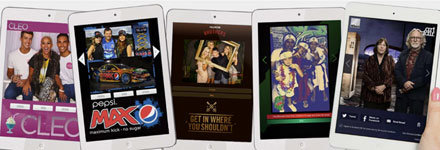
After working with the likes of the Internet Party, Schick, Metro magazine and 2degrees in the local market, Auckland-based digital company Interlike is now setting its sights on the Russian market.

Established in 2012 by commercial photographer Clinton Tudor (pictured right), commercial strategist Zlata K (pictured left) and digital specialist Kirill Kaplun, the company provides companies with the means to instantaneously deliver branded content to consumers via a specially designed app called Interlike Lite.
The app, typically used at brand-organised events, applies pre-set campaign branding to any photographs that are taken of those in attendance. These branded images are then distributed via social media to fans and potential consumers, thereby linking a real-life experiential event to the online community.
“Interlike New Zealand can customise Interlike Lite to include branding and design aspects such as borders, logos and watermarks with ease,” says Tudor. “High quality and creative photography has always been a powerful medium to bring a brand to life online. We just needed to move with the times and provide technology to make it a seamless and cost effective option for brands.”
Tudor says that since its launch, the business has grown “from a part-time project to a full-time operation employing nine full-time staff and a network of 30 freelancers”. And this local success served as the impetus behind the decision to extend the business into Russia.
“Interlike co-founder Kirill Kaplun is based in Moscow with the development team so it was natural to test the product in a bigger market with our team on the ground,” says Tudor.
The move into Moscow will see agency Vsyakij Sluchaj trial Interlike Lite in the country, using the same approach first developed in New Zealand.
Rather than selling the product at for one-off fee, Interlike maintains control of its IP by selling its services in conjunction with the app.
“Currently the app is available for use in partnership with Interlike New Zealand only,” says Tudor. “The Interlike specialists attend events with the app to ensure the content captured is the best quality and delivers to the brief. There are various packages available, which are flexible and tailored case by case. Pricing is a base day rate including photo enhancement kit and a device rental.”
In addition to attaching branding to all photography taken at an event, the app has also been integrated with analytics tools that Tudor says allow for “effective ROI measurement”.
“The app is integrated with Facebook page insights allowing Interlike New Zealand to provide feedback in the form of social engagement points (likes, tags, comments and shares) as well as organic reach to unique users and post impressions. The app also enables Interlike New Zealand to determine ROI per individual piece of content produced and unique users reached in the form of dollars per user and dollars per impression. For long-term campaigns, Interlike New Zealand can provide analysis by examining online trends that emerge as a result of using Interlike lite at events.”
According to Tudor, the effectiveness of the app was showcased during Interlike’s campaign for the Cleo Midori Bachelor of the Year 2014. He says that images captured during the event were shared instantly on Cleo’s Facebook page, and this branded content reached 55,409 unique users and tallied over 120,000 post impressions.
And Tudor isn’t drawing the line at Russia. He says that if the trials go well in the country, Interlike would definitely aim to branch out into other markets across the world.
This article originally appeared on StopPress.




